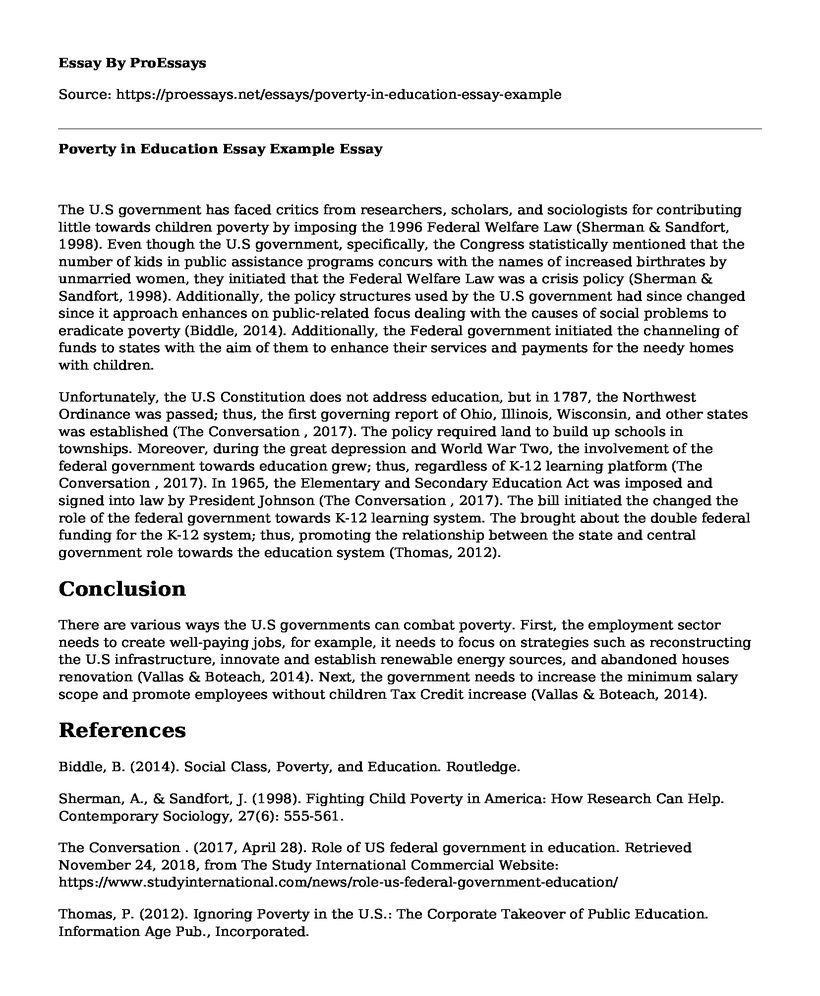The U.S government has faced critics from researchers, scholars, and sociologists for contributing little towards children poverty by imposing the 1996 Federal Welfare Law (Sherman & Sandfort, 1998). Even though the U.S government, specifically, the Congress statistically mentioned that the number of kids in public assistance programs concurs with the names of increased birthrates by unmarried women, they initiated that the Federal Welfare Law was a crisis policy (Sherman & Sandfort, 1998). Additionally, the policy structures used by the U.S government had since changed since it approach enhances on public-related focus dealing with the causes of social problems to eradicate poverty (Biddle, 2014). Additionally, the Federal government initiated the channeling of funds to states with the aim of them to enhance their services and payments for the needy homes with children.
Unfortunately, the U.S Constitution does not address education, but in 1787, the Northwest Ordinance was passed; thus, the first governing report of Ohio, Illinois, Wisconsin, and other states was established (The Conversation , 2017). The policy required land to build up schools in townships. Moreover, during the great depression and World War Two, the involvement of the federal government towards education grew; thus, regardless of K-12 learning platform (The Conversation , 2017). In 1965, the Elementary and Secondary Education Act was imposed and signed into law by President Johnson (The Conversation , 2017). The bill initiated the changed the role of the federal government towards K-12 learning system. The brought about the double federal funding for the K-12 system; thus, promoting the relationship between the state and central government role towards the education system (Thomas, 2012).
Conclusion
There are various ways the U.S governments can combat poverty. First, the employment sector needs to create well-paying jobs, for example, it needs to focus on strategies such as reconstructing the U.S infrastructure, innovate and establish renewable energy sources, and abandoned houses renovation (Vallas & Boteach, 2014). Next, the government needs to increase the minimum salary scope and promote employees without children Tax Credit increase (Vallas & Boteach, 2014).
References
Biddle, B. (2014). Social Class, Poverty, and Education. Routledge.
Sherman, A., & Sandfort, J. (1998). Fighting Child Poverty in America: How Research Can Help. Contemporary Sociology, 27(6): 555-561.
The Conversation . (2017, April 28). Role of US federal government in education. Retrieved November 24, 2018, from The Study International Commercial Website: https://www.studyinternational.com/news/role-us-federal-government-education/
Thomas, P. (2012). Ignoring Poverty in the U.S.: The Corporate Takeover of Public Education. Information Age Pub., Incorporated.
Vallas, R., & Boteach, M. (2014, September 17). The Top 10 Solutions to Cut Poverty and Grow the Middle Class. Retrieved November 24, 2018, from The American Progress Organization Website: https://www.americanprogress.org/issues/poverty/news/2014/09/17/97287/the-top-10-solutions-to-cut-poverty-and-grow-the-middle-class/
Cite this page
Poverty in Education Essay Example. (2022, Oct 23). Retrieved from https://proessays.net/essays/poverty-in-education-essay-example
If you are the original author of this essay and no longer wish to have it published on the ProEssays website, please click below to request its removal:
- Is College Worth It? Essay Example
- Paper Example on Sex Offender Registration Laws
- College Education Should Be Free - Persuasive Essay
- Essay Sample on Female Gender, Language and Culture
- Essay Sample on Angelika Grimke: Abolitionist & Women's Rights Advocate
- Essay Sample on Two Immigrants Seeking Rights: Sukra and Abdullah's Migration Story
- Essay Example on Ecology of a Cracker Childhood: Ray's Journey to Self-Discovery







